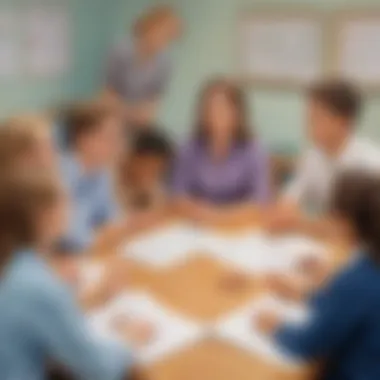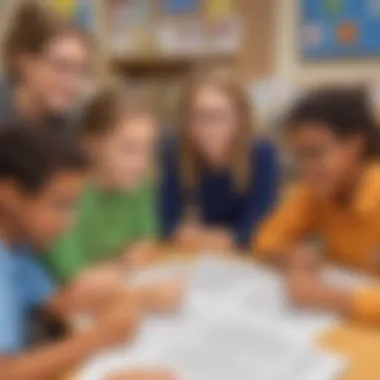Exploring Reciprocal Teaching Strategy in the Classroom


Intro
Reciprocal teaching is a pedagogical approach that emphasizes collaborative learning. It enhances students' reading comprehension and critical thinking skills through guided interactions. The strategy is grounded in four core components: predicting, questioning, clarifying, and summarizing. Each element serves to foster an environment where students actively engage with the material, thus deepening their understanding.
The emphasis on peer learning is essential in educational contexts. By participating in reciprocal teaching, students take on varied roles, which encourages accountability and mutual support. As educators, understanding how to implement this strategy effectively can lead to improved student outcomes, not just academically, but also in social interactions.
By analyzing reciprocal teaching, this guide aims to provide educators and parents with insights that are practical and applicable. The goal is to create a learning space that stimulates cognitive development and promotes engagement.
Interactive Learning Games
Interactive learning games are an effective way to incorporate reciprocal teaching principles. These games can be used in various classroom settings, adapting to different age groups and subject matter.
Popular Games
Educators can choose from an array of engaging games tailored to foster understanding and collaboration. Some popular options include:
- Kahoot!
- Quizlet
- Pictionary
- Scrabble for Kids
Each of these games can be modified to incorporate reciprocal teaching strategies, enhancing the overall learning experience.
Description of Top Educational Games
- Kahoot!: This game promotes teamwork and quick thinking. Students can answer questions collaboratively, which promotes peer discussion and understanding.
- Quizlet: A versatile tool for flashcards and quizzes. It allows students to create study sets that others can use, encouraging shared learning.
- Pictionary: The collaborative drawing game fosters creativity while allowing students to visualize concepts. Players can take turns guessing or describing, reinforcing their vocabulary.
- Scrabble for Kids: A classic word game that enhances spelling and vocabulary skills. It encourages students to engage with words in a competitive yet educational environment.
Benefits of Playing Educational Games for Kids' Cognitive Development
Playing educational games provides numerous benefits:
- Enhances critical thinking.
- Supports cooperative learning.
- Increases motivation to learn.
- Fosters communication skills.
These elements align seamlessly with reciprocal teaching, making games an excellent tool for educators.
Game Reviews
In-depth Reviews of Selected Educational Games
Kahoot!: Highly interactive, Kahoot! allows for real-time feedback which is crucial for guiding student understanding. It energizes classrooms and engages students of all levels.
Quizlet: Quizlet offers versatility with its learning modes. The ability to create and share personalized content introduces an element of ownership in learning.
Pictionary: Many students enjoy this game as it combines fun with learning. It can be tailored to focus on specific subject matter like science or literature terms.
Scrabble for Kids: By using a game format, students are encouraged to explore language in a low-stress situation. This nurtures a positive attitude towards vocabulary acquisition.
Comparison of Gameplay and Learning Outcomes
When comparing gameplay, it is evident that interactive games provide a dynamic way to learn. Games like Kahoot! emphasize speed and accuracy, thus enhancing strategic thinking. In contrast, Quizlet focuses on retention through repetition and social interaction. Each game offers unique learning outcomes, making them valuable tools in any reciprocal teaching strategy.
Educational Topics
This section will compile different articles covering a range of subjects. Focusing on interdisciplinary learning can enhance students' holistic development.
Importance of Interdisciplinary Learning for Holistic Development
Integrative learning promotes the application of knowledge across different disciplines. When students relate concepts from math to science, or literature to history, they can make connections that deepen their understanding. This approach nurtures critical thinking skills and encourages students to become lifelong learners.
Foreword to Reciprocal Teaching
Reciprocal teaching is a significant educational strategy that emphasizes collaborative learning. This method promotes an interactive classroom environment where teachers and students engage in dialogue to enhance understanding. The relevance of reciprocal teaching cannot be understated, particularly in an era where comprehension skills are paramount to academic success. Implementing this strategy encourages active participation and nurtures critical thinking among students.
Definition and Overview
Reciprocal teaching is fundamentally a guided practice that involves students taking responsibility for their own learning through peer collaboration. This strategy includes four primary components: predicting, questioning, clarifying, and summarizing. Each component aims to foster deeper comprehension and allows students to take on various roles, making the learning process dynamic. Under the guidance of an educator, students learn to engage with texts more thoughtfully. This method empowers students, transforming them from passive recipients of information into active learners.
Historical Context
The roots of reciprocal teaching date back to the 1980s, developed by Annemarie Sullivan Palincsar and Anne L. Brown. Initially designed to improve reading comprehension among struggling readers, this strategy has evolved over the decades. Researchers noticed that traditional methods often left students disengaged or reliant on the teacher. By introducing reciprocal teaching, the aim was to create a more interactive experience. Over time, studies supported its effectiveness across various grades and subject areas, underscoring its adaptability and robust potential.
Importance in Education


The importance of reciprocal teaching in education lies in its focus on developing comprehension skills. As educational standards increase, teachers must equip students with tools to analyze and evaluate information critically. This strategy promotes essential skills such as collaboration and communication. Students learn to articulate their thoughts and engage with peers in meaningful ways. Moreover, it nurtures a sense of accountability. Students realize that their contributions matter, which bolsters their confidence. The overall classroom atmosphere becomes one of support and exploration, leading to a richer educational experience for all participants.
Core Components of Reciprocal Teaching
Reciprocal teaching is anchored in four main components: predicting, questioning, clarifying, and summarizing. Each of these elements plays a crucial role in fostering comprehension and encouraging active engagement among students. By understanding and implementing these components, educators can create an environment that emphasizes interaction and deeper understanding. All four aspects complement each other, enhancing the overall learning experience.
Predicting
Predicting involves students making informed guesses about what they will read or learn. This strategy activates prior knowledge and sets a purpose for the reading task. When students predict, they engage their critical thinking skills. This process encourages them to make connections with the text, which helps in retaining information. It is essential for teachers to model this behavior, illustrating how to make effective predictions based on headings, visuals, or previous knowledge.
Students might ask questions like: "What do I think this chapter will be about?" or "What kind of information might I find in this text?" This practice not only improves their anticipatory skills but also motivates them to pay closer attention while reading.
Questioning
The questioning component of reciprocal teaching allows students to generate and answer their own questions about the text. This practice promotes curiosity and fosters a deeper understanding of the subject matter. When students formulate questions, they are less likely to passively absorb information; instead, they actively seek to clarify their understanding.
This could involve asking questions such as: "What is the main idea of this paragraph?" or "Why did the author choose this particular example?" Through questioning, students learn to evaluate their understanding and think critically about the content while engaging in meaningful discussions with their peers.
Clarifying
Clarifying requires students to identify and address any confusion regarding the material. This step is vital. It allows learners to request help when they encounter difficult concepts. Teachers can guide students on how to break down complex ideas into smaller, more manageable parts. When clarification occurs, it creates a supportive atmosphere that emphasizes collaborative learning.
Students can clarify by asking themselves or their peers: "What does this term mean?" or "Can you explain that concept again?" By engaging in this process, they improve their comprehension and learn to express their misunderstandings more clearly.
Summarizing
Summarizing encompasses the skill of distilling information into concise summaries. This involves capturing the main points and essential details from the text. The ability to summarize enables students to synthesize their learning. When they summarize, they demonstrate their mastery of the content. This is not only an important skill for academic success but also useful in real-life applications where key information must be communicated clearly and effectively.
In practice, students may face the prompt: "What are the main points we need to remember from this reading?" This exercise trains them to focus on the essential, enhancing knowledge retention and making connections between different ideas.
In summary, these core components of reciprocal teaching are interconnected and foster a well-rounded approach to learning. By integrating predicting, questioning, clarifying, and summarizing into their instructional strategies, teachers can significantly enhance students' comprehension and engagement.
Theoretical Framework Behind Reciprocal Teaching
The theoretical framework behind reciprocal teaching is crucial for understanding why this strategy is effective in educational settings. This framework is built on cognitive theories and constructivist principles, both of which inform the design and application of teaching methods. By understanding these concepts, educators can better engage students, enhancing their learning through structured peer interactions.
Cognitive Theories
Cognitive theories play a vital role in the reciprocal teaching approach. These theories emphasize mental processes such as thinking, remembering, and problem-solving. When students participate in reciprocal teaching, they are not passive recipients of information; rather, they actively engage with content through predicting, questioning, clarifying, and summarizing. This engagement encourages deeper cognitive processing, which is essential for comprehension.
One significant aspect of cognitive theory is the idea of metacognition. Metacognition refers to the awareness and regulation of one’s thinking processes. In reciprocal teaching, students learn to reflect on their understanding and learning strategies. This self-awareness helps them recognize what they know and identify gaps in their knowledge. Consequently, they become more effective learners.
"Cognitive engagement is the cornerstone of effective learning strategies. Reciprocal teaching exemplifies this through its focused interaction model, driving learners to synthesize information actively."
Constructivism in Learning
Constructivism is another critical element of the theoretical framework for reciprocal teaching. This theory posits that learners construct their own understanding and knowledge based on their experiences. In the reciprocal teaching model, this theory is applied through peer-led interactions, where students take turns leading discussions and guiding their peers.
Instructors foster an environment where students can express their thought process and collaboratively explore concepts. This approach allows learners to build on each other's ideas, leading to richer understanding. Furthermore, it helps students see diverse perspectives, promoting critical thinking skills.
For practical application, educators need to create a classroom climate that supports exploration and dialogue. This may involve establishing ground rules for discussions, ensuring all voices are heard, and encouraging respectful debates. By aligning reciprocal teaching with constructivist principles, teachers can maximize learning outcomes, providing students with the tools necessary for academic and personal growth.
Benefits of Reciprocal Teaching
Reciprocal teaching presents multiple advantages within educational settings. Understanding these benefits is crucial for teachers and students alike. This strategy fosters an environment conducive to learning, enhancing not only comprehension but also interpersonal skills. The subsequent sections will delve deeper into three main benefits: enhanced comprehension skills, promotion of collaboration, and fostering independence.
Enhanced Comprehension Skills
One of the most significant impacts of reciprocal teaching is its positive effect on students' comprehension skills. This method actively engages students in the learning process. By alternating roles in guiding discussions and promoting peer questioning, students deepen their understanding of the material. The processes of predicting, questioning, clarifying, and summarizing create a framework where students can refine their analytical abilities. Moreover, research indicates that students exposed to reciprocal teaching often demonstrate improved reading skills.
Key aspects of enhanced comprehension skills include:
- Active Engagement: Students are not passive recipients of information but are involved in creating meaning from the text.
- Metacognitive Awareness: Students learn to think about their thinking, increasing self-awareness in learning.
- Peer Learning: Interactions with peers provide different perspectives, enriching the learning experience.
Promotes Collaboration
Reciprocal teaching inherently promotes a collaborative learning environment. When students work together, they learn to share ideas and respect differing opinions. Collaboration is not just about working in groups; it involves meaningful dialogue and interaction. Research shows that students who engage in collaborative learning often achieve better outcomes. Such environments enhance social skills and emotional intelligence, vital attributes for future success.
Benefits of collaboration through reciprocal teaching include:


- Enhanced Communication Skills: Students practice articulating thoughts clearly and listening actively.
- Building Relationships: Collaborative settings foster friendship bonds, leading to a more connected classroom experience.
- Diverse Perspectives: Students are introduced to multiple viewpoints, promoting critical thinking.
Fostering Independence
Reciprocal teaching not only builds comprehension and collaboration but also fosters independence among students. As the method encourages students to take on different teacher roles, they gain confidence in their abilities to guide discussions and facilitate learning. This shift from teacher-centered to student-centered learning develops autonomy, where students feel responsible for their learning.
Elements of fostering independence in reciprocal teaching include:
- Self-Regulation: Students become more aware of their learning strategies and adjust as needed.
- Confidence Building: With a structured role, students are more likely to participate actively and share their insights.
- Ownership of Learning: By participating in discussions, students take charge of their educational journey, leading to a more meaningful learning experience.
"Reciprocal teaching not only enhances comprehension but cultivates an environment where students thrive together."
Understanding these benefits helps educators appreciate the potential of reciprocal teaching. When implemented effectively, the strategy addresses the diverse needs of students, all while promoting key skills necessary for academic and social success.
Implementation in the Classroom
Implementing reciprocal teaching strategies in the classroom is pivotal for cultivating an environment that prioritizes collaborative learning. As teachers design their lessons, focusing on effective implementation can lead to significant improvements in student comprehension and overall engagement. Facilitating such an approach requires careful attention to various elements that promote understanding and interaction among students.
Preparing Students
Preparing students for reciprocal teaching involves equipping them with necessary skills and understanding the context of collaborative learning. Teachers should begin by explicitly explaining the four components: predicting, questioning, clarifying, and summarizing. This foundational knowledge enables students to engage meaningfully during the process.
Encouraging practice is also essential. Role-playing these components can help solidify understanding. For instance, using texts familiar to the students can foster confidence as they move through each step of reciprocal teaching. Additionally, teachers can develop guides or graphic organizers that help students structure their thoughts and interactions. This preparation aids in reducing anxiety and builds a supportive atmosphere where students feel comfortable participating.
Facilitating Group Dynamics
Facilitating group dynamics is an integral aspect of successful reciprocal teaching. Group composition plays a crucial role; mixed-ability groups can enhance peer support, while same-ability groups might allow for deeper comprehension discussions. Teachers must create an atmosphere that encourages respect and open communication among group members.
Setting clear roles for students during sessions can enhance focus and accountability. Each member can be assigned responsibilities like summarizer, questioner, or clarifier to ensure every student contributes during the discussion. This approach also helps students to understand the value of diverse perspectives. Regularly rotating roles can prevent dominance by a few individuals and keeps every participant engaged.
Monitoring and Assessment
Monitoring and assessment are vital for evaluating the effectiveness of reciprocal teaching in the classroom. Teachers should continuously observe group interactions and provide feedback as needed. Utilizing formative assessments, such as anecdotal notes or checklists, can help highlight student progress and areas needing improvement. This ongoing evaluation informs instruction and allows for necessary adjustments to teaching strategies.
Furthermore, peer assessments can be employed, where students reflect on their contributions and those of their peers. This self-reflection promotes a sense of responsibility and encourages students to take ownership of their learning journey. An example of an assessment tool can be simple rubrics that outline expected behaviors and contributions during reciprocal teaching sessions.
The implementation of reciprocal teaching not only boosts comprehension but also nurtures essential skills such as collaboration and communication.
In summary, effective implementation of reciprocal teaching involves preparing students through foundational knowledge, facilitating positive group dynamics, and continuously monitoring progress. These elements collectively enhance the learning experience and contribute to creating an engaging classroom that fosters independent and critical thinkers.
Challenges in Reciprocal Teaching
Reciprocal teaching offers valuable strategies to boost comprehension and collaboration. Nevertheless, it is not without its challenges. Addressing these challenges is essential for effective implementation in the classroom. Educators must anticipate obstacles and plan for them. This section will examine some common issues that arise during reciprocal teaching, such as student resistance, variability in learning styles, and time management issues.
Student Resistance
Student resistance can manifest in various forms. Some learners may feel uncomfortable participating in peer-led discussions. Others might be skeptical of this cooperative method. It is important for educators to recognize and address these feelings early in the process. One strategy is to create a safe environment where students feel respected. Setting clear expectations and building rapport with learners can help ease their concerns. Engaging students in the planning phase can also foster a sense of ownership and responsibility. Educators should promote the benefits of reciprocal teaching, such as improved understanding and engagement. By shifting the focus to student benefits, educators may successfully reduce resistance.
Variability in Learning Styles
Each student has a unique learning style. Some may thrive in collaborative settings, while others might require individual attention. Recognizing and accommodating this variability is key to the effectiveness of reciprocal teaching. Educators should observe their students closely and gather feedback to determine individual preferences. Developing flexible groups can enhance participation. It's crucial to provide various roles within each group, allowing students to leverage their strengths. This adaptability helps maintain balance in the classroom. Educators must communicate openly, calling for adjustments and ensuring that all voices are heard during discussions. Observing the dynamics can lead to better outcomes for every student.
Time Management Issues
Time management poses another challenge for implementing reciprocal teaching. The method demands significant time for discussions and interactions, which can impact the overall curriculum. Therefore, careful planning is essential. Educators can allocate specific periods for reciprocal teaching activities. This could be done during reading sessions, where designated time slots allow for thorough discussions. Planning lessons around group interactions can minimize time constraints. Setting a clear agenda for each session can help streamline activities. Additionally, keeping track of discussions might streamline learning and ensure that key points are addressed efficiently. This structured approach can alleviate pressures on the curriculum while maximizing the benefits of reciprocal teaching.
Collaboration and adaptability are critical to successfully navigating the challenges of reciprocal teaching.
Examples of Effective Reciprocal Teaching Practices
The exploration of effective reciprocal teaching practices is crucial for realizing the potential of this teaching strategy. It provides educators with practical applications that can lead to improved student outcomes. Understanding and implementing these practices can help promote a classroom environment conducive to collaboration and comprehension.
Case Study Analysis
Analyzing case studies of reciprocal teaching reveals a range of successes and challenges faced by educators implementing the strategy. One notable example took place in a third-grade classroom at Lincoln Elementary School. The teacher introduced reciprocal teaching by focusing on the four components: predicting, questioning, clarifying, and summarizing. Over the course of several weeks, students were divided into small groups. They were encouraged to lead discussions around assigned reading materials. The results were significant; students demonstrated improved comprehension skills and exhibited greater engagement with the material.
Educators found that specific strategies, like modeling think-alouds and structured discussions, yielded positive results. Students became more adept at formulating questions and providing clarity on complex topics. By reflecting on successful case studies, teachers can adopt proven techniques and modify them to suit their classroom dynamics.
Adaptation for Different Age Groups


Adapting reciprocal teaching strategies for different age groups is essential for meeting diverse learning needs. With younger students, such as in kindergarten, the focus might be on playful interactions while guiding them through stories. Educators could use picture books, asking children to predict story outcomes or identify key events. The emphasis is on engaging with the material in a way that feels approachable and fun.
In contrast, for high school students, reciprocal teaching can take a more analytical tone. Discussions may center around themes in complex texts, allowing older students to pose challenging questions and summarize nuanced viewpoints. This age group benefits from deeper discussions that foster critical thinking.
Utilizing tailored approaches will ensure that the core principles of reciprocal teaching remain intact, while also being accessible to students at varying developmental stages.
Through careful analysis and adaptation, reciprocal teaching practices can effectively cater to the needs of learners, ultimately enhancing their educational experiences and comprehension skills.
Role of Educators in Reciprocal Teaching
The role of educators in reciprocal teaching is crucial for the success of this pedagogical approach. As facilitators, teachers guide students through the structured process of learning to enhance comprehension. Their engagement directly influences the effectiveness of the strategy. This section delves into specific elements, benefits, and considerations surrounding educators' involvement in reciprocal teaching.
Instructor as a facilitator
Educators must embody the role of facilitator in reciprocal teaching. This means creating an environment where students feel comfortable to share ideas and ask questions. The instructor’s primary task here is to guide discussions without dominating them. This ensures that students are not only participants but also active contributors to their learning.
Facilitating involves several key responsibilities:
- Modeling the Strategy: Educators demonstrate the four components—predicting, questioning, clarifying, and summarizing. By exemplifying these strategies, teachers reinforce their importance and efficacy.
- Encouraging Participation: A good facilitator promotes equal participation. They encourage quieter students to contribute, fostering a more inclusive environment.
- Providing Feedback: Constructive feedback helps students refine their comprehension skills. Teachers need to affirm correct understanding while gently correcting misconceptions.
- Monitoring Group Dynamics: Effective group dynamics are essential for successful reciprocal teaching. Teachers must observe interactions, stepping in when necessary to maintain focus or to redirect discussions.
Instructors who excel in these areas contribute significantly to effective reciprocal teaching. It’s essential that educators remain adaptable, responding to the unique needs of their students.
Professional Development and Training
For educators to effectively implement reciprocal teaching, ongoing professional development is necessary. Training programs equipped with current research and practical strategies enable teachers to refine their skills. Here, several aspects of professional development come into play:
- Workshops and Seminars: Participating in workshops focused on reciprocal teaching provides educators with hands-on experiences. These sessions often include role-playing and collaborative planning, essential for practice.
- Peer Collaboration: Teachers should share experiences and best practices with colleagues. Collaborative planning sessions can lead to innovative teaching methods tailored to reciprocal teaching.
- Access to Resources: Providing educators with access to literature—journal articles, books, and online resources—can enhance understanding of reciprocal teaching strategies. Resources from platforms like Wikipedia, Britannica, and even forums such as Reddit can be beneficial.
- Reflective Practices: Encouraging educators to engage in reflective practices helps them assess their teaching methods and explore areas for improvement. Reflection promotes continuous growth and adaptation in teaching styles.
Investing in professional development ensures educators remain informed about the latest research in reciprocal teaching, enhancing their capacity to facilitate rich learning experiences.
"Educators are more than just conveyors of knowledge; they play a pivotal role in shaping how students engage with learning strategies."
Adapting Reciprocal Teaching for Online Learning
Adapting reciprocal teaching for online learning is vital in today's educational landscape. The shift to remote education demands flexibility in teaching strategies. Reciprocal teaching, with its collaborative essence, still holds relevance in a virtual context. This section examines how to effectively incorporate the strategy into online formats, revealing its benefits and notable considerations.
Tools and Platforms
To implement reciprocal teaching online, educators must select appropriate tools and platforms that facilitate interaction. Some popular tools include:
- Zoom: Ideal for live sessions enabling face-to-face interaction, which is crucial for reciprocal teaching.
- Google Classroom: Helpful for sharing materials and tracking student progress in a central location.
- Padlet: Encourages collaboration by allowing students to post ideas and feedback in a shared space.
- Miro: A virtual whiteboard that can be used for brainstorming, summaries, and visual discussions.
These platforms streamline the reciprocal teaching process, ensuring that students can effectively engage with one another and with their instructors. Each tool offers distinctive features that cater to various aspects of the reciprocal teaching process.
Engaging Students Remotely
Engaging students remotely presents unique challenges. To ensure active participation in reciprocal teaching, consider these approaches:
- Small Group Breakout Sessions: Divide students into smaller groups during online sessions. This strategy fosters a comfortable environment for discussion and peer support.
- Interactive Polls and Quizzes: Use tools like Kahoot! or Mentimeter to assess comprehension and keep students focused on the discussion topics.
- Visual Aids: Share visual content such as videos or infographics to spark interest and illustrate concepts better.
- Routine Feedback and Encouragement: Provide regular feedback to maintain student motivation. Highlight contributions and progress to encourage continued participation.
By utilizing these tactics, educators can bridge the gap between traditional and online learning, ensuring that the essence of reciprocal teaching thrives in digital settings.
Engaging students in virtual environments requires thoughtful strategies to maintain focus and encourage collaboration.
In adapting reciprocal teaching for online learning, it is crucial to embrace technology and remain attentive to student needs. This preparation can ultimately lead to a successful implementation of reciprocal teaching principles in any educational setting.
Future Directions for Reciprocal Teaching Research
Research into reciprocal teaching continues to evolve, highlighting the importance of exploring new avenues and emerging trends. This section will examine the relevance of future directions in reciprocal teaching research, focusing on how ongoing inquiries can enhance educational practices. As educators and researchers dive into this topic, certain elements stand out that could greatly benefit teaching methodologies and learning outcomes.
The ongoing evolution of educational technology along with shifts in student demographics calls for innovative strategies in teaching, making future research crucial. By examining various student contexts and refining reciprocal teaching methods accordingly, researchers can contribute to a more effective learning environment.
Emerging Trends
One notable trend is the integration of technology into reciprocal teaching practices. With the rise of digital tools, platforms like Google Classroom and Zoom enable teachers to facilitate reciprocal teaching in virtual settings, expanding accessibility for diverse learners. Using video conferencing allows students to engage in discussions that mimic face-to-face interactions, making the strategy adaptable to online learning spaces.
Another emerging trend involves focusing on differentiated instruction within reciprocal teaching. As educators aim to meet the needs of all students, research may explore how tailoring reciprocal teaching practices can support varying learning styles. By integrating multimedia resources or group formats, teachers can help facilitate the core components effectively for every student, regardless of their educational background.
Potential Areas of Study
One significant area for future study is the impact of reciprocal teaching on teacher-student interactions. Investigating how instructional strategies affect classroom dynamics can offer insights into best practices for implementing reciprocal teaching effectively. Exploring how teachers can balance guidance and independence in group settings is crucial for effective collaboration.
Additionally, studying the long-term effects of reciprocal teaching on student comprehension and retention may provide valuable information. Research could focus on how repeated exposure to the four key components—predicting, questioning, clarifying, summarizing—affects students’ reading abilities over time. Understanding these long-term effects will inform both classroom practices and curricular decisions.
Overall, the future of reciprocal teaching research promises to enhance educational practices substantially. By addressing emerging trends and focused areas of study, this research can help educators refine their methods, ensuring that all students benefit from this collaborative learning strategy.















